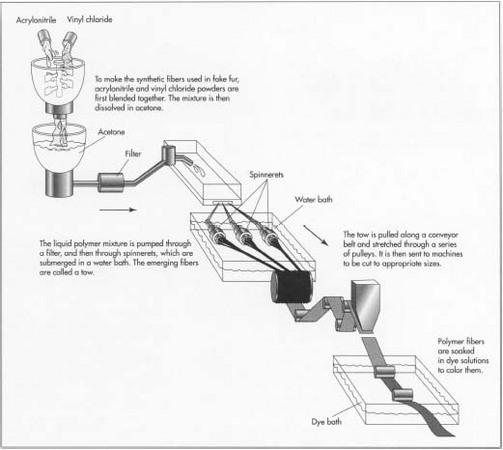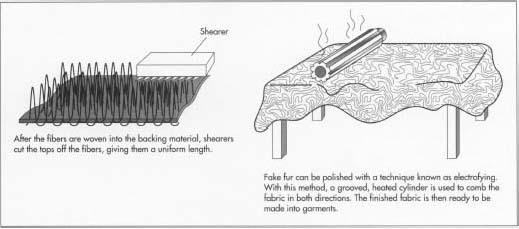Fake Fur
Fake fur is a type of textile fabric fashioned to simulate genuine animal fur. It is known as a pile fabric and is typically made from polymeric fibers that are processed, dyed, and cut to match a specific fur texture and color. First introduced in 1929, advances in polymer technology have tremendously improved fake fur quality. Today's fake furs can be nearly indistinguishable from the natural furs they imitate.
History
Fur is one of the oldest known forms of clothing, and has been worn by men and women for a variety of reasons throughout history. While quite desirable, real fur had the disadvantage of being expensive and in short supply. For this reason, fake furs were introduced on the market in 1929. These early attempts at imitation fur were made using hair from the alpaca, a South American mammal. From a fashion standpoint, they were of low quality, typically colored gray or tan, and could not compare to exquisite furs like mink or beaver. But the fabric was inexpensive and warm, so manufacturers continued to develop improved versions of the fake fur, trying to give it a denser look, better abrasion resistance, and more interesting colors.
In the 1940s, the quality of fake furs was vastly improved by advances in textile manufacture technology. However, the true modern fake furs were not developed until the mid 1950s, with the introduction of acrylic polymers as replacements for alpaca hair. These polymers were particularly important because they could provide the bulk required to imitate real fur without the weight associated with other fake fur fabrics. They were also easier to color and texture than alpaca fibers. Later in the decade, polymer producers found that acrylic polymers could be made even more fur-like and fire resistant by mixing them with other polymers. These new fabrics, called modacrylics, are now the primary polymer used in fake fur manufacture.
Background
Fake furs are known as pile fabrics, which are engineered to have the appearance and warmth of animal furs. They are attached to a backing using various techniques. Although they can never match the characteristics of natural furs, fake furs do have certain advantages over their natural counterparts. Unlike natural furs, fake furs can be colored almost any shade, allowing for more dramatic color combinations. Additionally, fake furs are more durable and resistant to environmental assaults. In fact, some are even labeled hand washable. With concerns over the enviromnent and animal rights, more and more fashion designers are developing garments using fake fur. Lastly, fake furs are much less expensive than natural furs, making them an attractive option for many people.
Raw Materials
Fake furs are made with a variety of materials. The bulk fibers are typically composed of polymers, including acrylics, modacrylics, or appropriate blends of these polymers. Acrylic polymers are made from chemicals derived from coal, air, water, petroleum, and limestone. They are the result of a chemical reaction of an acrylonitrile monomer under conditions of elevated pressure and heat. For fake furs, secondary monomers are also added to improve the ability of the acrylic fibers to absorb dyes. Modacrylic polymers are copolymers made by the reaction of acrylonitrile and vinyl chloride monomers. These fibers are particularly useful for fake furs because they can be easily dyed with animal-like colors and have a natural fire retardance.
Modacrylic and acrylic polymers have other characteristics that make them useful in fake fur manufacture. They are light-weight and springy, imparting a fluffy quality to the garment. They are also highly resistant to heat, sunlight, soot, and smoke, are strong and resilient, and show good stability during laundering. Since they are thermoplastic polymers, they can be heatset. They resist mildew and are not susceptible to attack from insects. These polymers also have very low moisture absorbency and will dry quickly.
Other naturally occurring fabrics are also used to make fake furs and improve the look and feel of the overall garment. These include materials such as silk, wool, and mohair. Cotton or wool, along with polypropylene, are typically used to make the backings to which the fibers are attached. Rayon, a semisynthetic fiber made from cellulose and cotton linters, is used to supplement acrylic and modacrylic fibers on the garment, as are polyester and nylon. Materials such as silicones and various resins are used to improve the smoothness and luster of fake furs. To complete the look of a fake fur, dyes and colorants are used. If a true imitation is desired, designers match the color with natural fur. However, fashion designers have found that the fake fur fabric has merits of its own and have started using colors and styles that give it its own new, unique look.
The Manufacturing
Process
The production of a fake fur can be a mostly automated process. The manufacturing steps involved include production of the synthetic fibers, construction of the garment, and modification of the garment.
Chemical synthesis of fibers
- 1 Making a fake fur begins with the production of the synthetic fibers. While different types of polymers are used, modacrylic polymers provide a good illustration of the fiber manufacturing process. First, the acrylonitrile and vinyl chloride monomers are mixed together in a large stainless steel container. They are forced into a chamber in which the pressure and temperature is increased. Mixing blades are constantly in motion and the polymerization process begins. A white powdery resin is produced, which is then converted into a thick liquid by dissolving it in acetone.
- 2 The liquid polymer mixture is then pumped through a filter to remove undissolved particles. From the filter, the material is pumped through spinnerets, which are submerged in a water bath. The spinnerets look similar to shower heads, and when the polymer is extruded through, it emerges as a group of continuous fibers called a tow.
- 3 The tow is then pulled along a conveyor belt and stretched through a series of pulleys. As the tow is stretched, it is also washed and dried. As it dries, the acetone is driven off, leaving only the polymer. The continuous fibers are then annealed, making them stronger, and are sent to a machine that cuts them to appropriate sizes.
- 4 After various quality control checks are performed on the fibers, they are moved to the next phase of processing. Here, the polymers are soaked in dye solutions and colored. While this is not the only phase of manufacture in which the fibers are colored, this is usually the point where solid background colors are obtained.
Producing the fur
-
5 While the fibers provide the primary texture and look for imitation fur, the backing provides most of the structure. Working off a specific garment design, the backing, which is made out of cotton or wool, is sent through a machine to be appropriately cut. It is then transferred to the next phase of production, in which the fibers will be attached.

- 6 To convert the fibers into a garment, four different techniques can be employed. The most basic method is the weaving process. In this process, the fibers are looped through and interlaced with the backing fabric. While this technique is fairly slow, it can produce a large range of cloth shapes. Another method of fake fur production is called tufting. It is similar to weaving; however, it produces garments at a much higher rate of speed. Circular loop knitting and sliver knitting are other methods of fake fur garment production. Sliver knitting utilizes the same equipment used in jersey knitting. This makes it the fastest and most economical of all the fake fur garment production techniques, and it is also the one most used by manufacturers.
Finishing touches
-
7 To simulate a natural fur, the garments are treated in various ways.
First, to ensure that the fake fur will remain unchanged after it is
produced, the fabric is heated. This heat setting process preshrinks the
fabric, giving it improved stability and expanded fiber diameters. Next,
to remove loose fibers from the fabric, wire brushes are passed through
the fabric. This process is known as tigering. Rough shearing of the
fibers by cutting them with a set of helical knives gives
them a uniform length. The luster of the fabric can be improved through a method known as electrofying. This is a polishing technique that involves combing the fabric with a heated, grooved cylinder in both directions. The next treatment is the application of chemicals such as resins and silicones, which improves the feel and look of the fiber. Coloring to simulate specific animals can also be enhanced at this staged. Another round of electrofying can be done, as well as a finishing shearing to remove any remaining loose fibers. Depending on the type of fake fur, embossing to simulate curls can also be done during this stage of manufacture.

- 8 After the fake fur has been produced, the government requires that they are labeled as imitation fur fabrics. These labels are typically sewn in the inside of the garment and must be legible throughout the life of the product. In the final steps of fake fur manufacturing, the garment is put in the appropriate packaging and shipped to distributors.
Quality Control
To ensure the quality of fake fur, manufacturers monitor the product during each phase of production. This process begins with an inspection of the incoming raw materials and continues with the finished fibers that are produced in the polymerization reactions. These fibers are subjected to a battery of physical and chemical tests to show that they meet the specifications previously developed. Some of the characteristics that are tested include pH, appearance, density, and melting point. Other things such as fiber elasticity, resilience, and absorbency can also be tested.
As the garments are being produced, line inspectors take random samples at certain time intervals and check to ensure that they meet set requirements for things such as appearance, sewing quality, fiber strength, size, and shape. The primary testing method is visual inspection, although more rigorous tests can also be performed. In addition to the manufacturer's own standards, the industry and government also set requirements. A set of governmental standards, known as L-22, has been voluntarily adopted by the industry. These tests outline minimum performance standards for things such as shrinkage, pilling, snagging, and wear.
The Future
The technology of producing fake furs has improved greatly since the early twentieth century. Future research will focus on developing new fibers and finishes. These polymeric fibers will have improved feel, look, and a lower cost. Additionally, quicker and more efficient methods of production are also being investigated. Special animal simulation techniques have recently been developed. One method simulates the long and short hair sections of mink or river otter fur by mixing shrinkable and non-shrinkable fibers. Another method simulates the feel of beaver fur by mixing certain fine and coarse fibers. Finally, manufacturers will strive to produce ever higher quality products at the lowest possible cost.
Where to Learn More
Books
Jerde, Judith. Encyclopedia of Textiles. Facts on File, 1992.
Keeler, Pat and Francis McCall. Unraveling Fibers. Atheneum Publishers, 1995.
Harris, Jennifer. Textiles 5,000 Years: An International History and Survey. Harry N. Abrams Publishing Co., 1993.
Seiler-Baldinger, Annemarie. Textiles: A Classification of Techniques. Smithsonian Institute Publications, 1995.
— Perry Romanowski
Comment about this article, ask questions, or add new information about this topic: